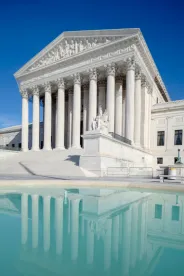Readers are likely aware that the Supreme Court of the United States has issued a ruling, in Alice Corporation Pty. Ltd. v. CLS Bank International, et al. CERTIORARI TO THE UNITED STATES COURT OF APPEALS FOR THE FEDERAL CIRCUIT No. 13–298. Argued March 31, 2014—Decided June 19, 2014. Also, the United States Patent and Trademark Office (USPTO) issued on June 25, 2014 a memorandum on the above subject. What do we as patent practitioners expect and do in the aftermath?
A consensus is emerging among numerous blogs and among colleagues that this is not a disaster for software-based patents, as some originally feared. Initially, it appeared to some that the Supreme Court ruling provides a blueprint for invalidating software-based patents, or rejecting software-based patent applications. The Supreme Court reduced all of the claims in four issued patents to variations of “An instruction to apply the abstract idea of intermediate settlement using some unspecified, generic computer” (see syllabus page 3). Apparently, all one has to do to invalidate a software-based patent or reject a software-based patent application is show that claims in such a patent or patent application are directed to an abstract idea, and show that any structural limitations (in the independent claims or the dependent claims) involving computers or other structural elements are devoid of “an ‘inventive concept’ sufficient to ‘transform’ the claimed abstract idea into a patent-eligible application” (see page 11 opinion of the court, citing Mayo). Since, as many have noted in various words (see especially the dissenting opinions in the original case), it is a straightforward manner to declare that just about any patent can be abstracted to an abstract idea at its foundation or core, it might seem at first glance the Supreme Court ruling puts software-based patenting as an overall category at risk. Of course, the real answer as to whether or not this is so, and how narrow or broad the ruling is, will play out in the courts (e.g., Digitech Image Technologies LLC v. Overstock 2013-1600-1618 (Fed Cir. 2014)) as the Supreme Court ruling is interpreted and applied.
Meanwhile, the USPTO June 25, 2014 memorandum, while not having the force of law, nonetheless provides analysis of the Supreme Court ruling that we can use as guidelines for drafting claims in software-based patent applications. And, the memorandum reminds us (on page 1) that “Notably, Alice Corp. neither creates a per se excluded category of subject matter, such as software or business methods, nor imposes any special requirements for eligibility of software or business methods.” The memorandum is directed to Examiners looking at patent applications. Now, we know a bit more about what the Examiners in the USPTO are looking for. One of the aspects they are looking for (see Part 2, page 3 of the memorandum) is whether the claim has limitations that qualify as “significantly more” than an abstract idea in and of itself. Examples of limitations that might qualify as “significantly more” include “Improvements to another technology or technical field; Improvements to the functioning of the computer itself; Meaningful limitations beyond generally linking the use of an abstract idea to a particular technological environment.” Examples of limitations that might not be enough to so qualify include “Adding the words ‘apply it’ (or an equivalent) with an abstract idea, or mere instructions to implement an abstract idea on a computer; Requiring no more than a generic computer to perform generic computer functions that are well-understood, routine and conventional activities previously known to the industry.”
Structure, Structure, Structure. The antidote to an assertion that claims are merely an abstract idea combined with the instruction to “apply it” is to add structure to the claims. Remember, abstract can be defined as non-concrete, mental, non-material, separated or apart from actual or real objects, among other definitions. Reciting structural limitations anchors the claim to actual or real objects. The machine or transformation test, while not necessarily absolute, is still relevant. Reciting specific components in a computer, particularly components that have a novel function or structure, may qualify the claim as patent-eligible subject matter. This tactic moves the computer away from being a generic computer, and may qualify as an improvement to the so-called generic computer. Tying the claim to a specific technology, e.g., by reciting structural elements indicative of that technology, may qualify the claim as patent-eligible subject matter. Then, it can be argued that the claim shows improvements to the technology or the technical field. This could be especially helpful if the specific technology is not necessarily implied in the abstract idea in and of itself. In a method claim, or an apparatus or system claim involving a function (which could be interpreted as a method), adding actions to the claim that amount to more than just “apply it” may qualify the claim. A result specific to a particular technology, or an unexpected result, while not mentioned in the memorandum, might also help qualify the claim as patent-eligible subject matter. Reciting, in the claims, a computer function that is not well-understood, routine and conventional in the industry might be useful. Software-based patenting is alive and well, we just need to adapt to changes in the legal arena. This is all part of the art of patenting.




 />i
/>i

